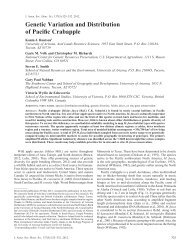CONSERVATION
Conservation You Can Taste - The Southwest Center - University of ...
Conservation You Can Taste - The Southwest Center - University of ...
- No tags were found...
You also want an ePaper? Increase the reach of your titles
YUMPU automatically turns print PDFs into web optimized ePapers that Google loves.
distinctively American foods. “It’s hot, but it’s not too hot. You<br />
know, it’s not so hot that it overpowers, but it would if you<br />
used too many.” At roughly 2 inches and yellow-orange in<br />
color, its heat is deceptive. Its fruitier tropical flavor is the kind<br />
that will snag you at the back of the throat when you’re least<br />
expecting it. It’s Scoville strength rates at 350,000, putting it<br />
in nearly the same range as the Habanero or Scotch Bonnet.<br />
Chef Bearl feels that once people are introduced to it, the<br />
Datil pepper definitely sells itself. Although it is related to the<br />
fiery Habanero, the Datil sells itself with its fragrances and<br />
flavors of tropical fruits. “We did a meat project for a couple<br />
years and we started making sausages and things and were<br />
putting this pepper in the sausage. And by God did we have a<br />
(unique) product.”<br />
Bearl, the former director of the Culinary Arts program<br />
at First Coast Technical College in St. Augustine, Florida, has<br />
been passionate about the Datil peppers for roughly fifteen<br />
years. “If you live in St. Augustine you can’t not hear about<br />
the Datil.”<br />
In the 1980s, the seeds were virtually unavailable outside of<br />
St. Augustine, and few heirloom seed savers across the country<br />
had ever heard of the variety; in fact, the Datil’s cousin, the<br />
Habanero, had yet to become a hit in the U.S. Chris Way of<br />
Barnacle Bill’s restaurants in St. Augustine began to sell the first<br />
commercial Datil pepper hot sauce in 1981, but at that time, you<br />
could count the number of small-scale growers of these peppers<br />
on one hand.<br />
Then, eight years ago, Bearl saw an opportunity to use<br />
the Datil to help connect the growers and consumers in his<br />
community. Although locals were already enthusiastic about<br />
the pepper and took pride in it, few had access to enough plants<br />
to grow for themselves or to sell to the budding Datil pepper<br />
microenterprises. He suggested to the college’s horticultural<br />
25



